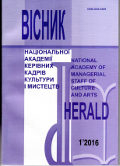SLAVIC CYRILLIC MANUSCRIPT HERITAGE IS A MODEL OF NON-MATERIAL CULTURE OF UKRAINE
DOI:
https://doi.org/10.32461/2226-3209.1.2016.138471Keywords:
Ukrainian manuscript heritage, intangible culture, revival and preservation of knowledge system,Abstract
The handwritten Ukrainian heritage as a unique phenomenon of intangible culture is analyzed. The author has developed a new program that is associated with the revival and preservation of Ukrainian handwritten heritage. In some samples it is shown the effect of the program, manuscripts presented as intangible culture phenomenon.
Turning to development, and most importantly preservation of intangible culture in Ukraine, attention is focused on such concepts as heritage or handwritten manuscript heritage of Ukraine. It seems to be manuscript artefacts. You can see, pick up, move from place to place, but there is another side of this issue, it is the knowledge of the manuscript which forms a field of research. This sphere in Ukraine is studied by scientists, but as something intangible culture considered insufficient. Therefore this research topic is relevant and meaningful.
Addressing the issues associated with the revival and preservation of national heritage Ukraine is an urgent need to form a picture of reciting information about them. Manuscripts heritage in general is the genetic code of the nation and the best and most truthful for manuscript nobody can tell that historic event and do not show cultural traditions and achievements of this nation. However, the formation of knowledge about the manuscript heritage of a country needs a system.
The presence of a certain number of documents that are designed to recovery, growth, preservation of manuscripts and cultural heritage not only Ukraine and Greece, but also around the world, indicates the existence of endless problem of white spots that remain on not address the issues of return and preservation national heritage of different countries. And Ukraine is not an exception, but rather one of the most affected countries of modern Europe. This is a permanent removal, colouring Ukrainian values, but also the transformation of history and attempts to destroy Ukraine for centuries as state as a nation.
The program UNESCO "Memory of the World" aims to promote the conservation of world heritage manuscript. The author of this work offers its own, narrower version of the study, it is the identification and preservation of Ukrainian manuscripts in Slavic and Greek collections in Europe. Name of the program, "Manuscripts Ukrainika. European practice".
Identifying manuscript, its belonging to one or another tradition are researched by using the aforementioned semiotic methods. All this forms are a system and rather discipline handwriting heritage of Ukraine. It, in turn, provides the basis and principles of manuscripts, attributed to the unique phenomena of intangible culture.
Availability manuscript, even as precious sample material culture, is characterized as a unit, property, inheritance pattern of ancient manuscripts. These manuscripts are as unique monuments that belong to one or another tradition that has typical or not typical structure that belongs to a hierarchical type in a hierarchical structuring of manuscript heritage that has certain domestic content differences manuscript etc. In the presence of the aforementioned complex knowledge manuscript receives individual assessment, description, introduction to the catalogue, filming, digitization and, uniqueness publication. After that, heand the intangible value again becomes a financial update memo, which will be preserved for future generations.
Downloads
Published
Issue
Section
License
Authors who publish with this journal agree to the following terms:
1. Authors retain copyright and grant the journal right of first publication with the work simultaneously licensed under a Creative Commons Attribution License International CC-BY that allows others to share the work with an acknowledgement of the work's authorship and initial publication in this journal.
2. Authors are able to enter into separate, additional contractual arrangements for the non-exclusive distribution of the journal's published version of the work (e.g., post it to an institutional repository or publish it in a book), with an acknowledgement of its initial publication in this journal.
3. Authors are permitted and encouraged to post their work online (e.g., in institutional repositories or on their website) prior to and during the submission process, as it can lead to productive exchanges, as well as earlier and greater citation of published work (See The Effect of Open Access).


